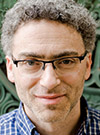Year of the Humanities Profile: What Are the Origins of the Universe?
Years ago, as a University of Chicago graduate student, Arthur Kosowsky’s research was a conversation-stopper at parties. Anytime he would mention he was studying theoretical physics, the partygoers’ eyes would glaze over before they would turn away to talk to someone else.
 But today, more than 20 years later, when he happens to mention that he’s a University of Pittsburgh professor of physics and astronomy, people’s eyes light up. “Wow, you do that?” they might say. “What is the story with black holes?” Or, “I just read about astronomers discovering a new asteroid.”
But today, more than 20 years later, when he happens to mention that he’s a University of Pittsburgh professor of physics and astronomy, people’s eyes light up. “Wow, you do that?” they might say. “What is the story with black holes?” Or, “I just read about astronomers discovering a new asteroid.”
Headlines about topics such as the Hubble Space Telescope; the movie about physicist Stephen Hawking, The Theory of Everything; and the discovery of water on Mars have done more than make Kosowsky more popular at parties. They have captured the imagination of lots of people who ponder how the universe was formed more than 13 billion years ago.
Looking up at the heavens raises one of the most basic human questions posed throughout the centuries, said Kosowsky: What are the origins of the universe, of us?
Though his research is steeped in advanced mathematics, computer programming, and abstract scientific terms, he views it as a human and universal story about our origins. “In some sense, it is the greatest example of humanistic endeavor in all of history,” he said.
“How the universe began and how it evolved, that is fundamentally our modern creation story,” he said. “Every culture in the history of humanity has a creation myth. Now we have a story that is not a myth. It is based on observations and science.”
As Pitt celebrates the Year of the Humanities in the University, it’s useful to see how a range of people from diverse fields draw from the humanities in their work.
Kosowsky serves on the steering committee for this year’s celebration of the humanities at Pitt. Joining him are faculty from diverse areas, including pharmacy, business, engineering, law, and political science, as well as colleagues from English literature, music, and other humanities departments.
In addition to courses in advanced physics and cosmology, Kosowsky taught “The History of Astronomy: Stonehenge to Hubble” to a class of mostly non-science majors.
“Astronomy is probably the oldest continually documented human endeavor” dating back to Stonehenge, the prehistoric monument located in Wiltshire, England, he said. “Stonehenge had clear astronomical purpose. It aligned certain ways with awareness of the sky.”
From the early Babylonians to the ancient Greeks, people have put a lot of time, energy, and creativity into studying the stars, Kosowsky added. Farmers used early astronomy to determine the growing seasons.
The Pitt physicist grew up in Omaha, Neb., fascinated by science and the sci-fi worlds invented by Isaac Asimov and other writers. But he also was a top English student, winning a writing prize his senior year.
After earning a bachelor’s of science degree in physics at Washington University in St. Louis in 1989, he received a PhD in physics from the University of Chicago in 1994 and was a Junior Fellow in the Society of Fellows at Harvard University.
He entered the field of cosmology—a branch of astronomy that studies the cosmos— in the early ’90s, a period of astonishing breakthroughs. Before then, “cosmology was considered a little out-there, these crazy guys making up wacky theories. There was no serious doubt that the Big Bang had happened. But we had very little information on the basic properties of the universe.”
The field was transformed by many experiments that enabled scientists to research and map out the thermal radiation generated in the aftermath of the Big Bang, called cosmic microwave background. It’s the radiation released about 370,000 years after the Big Bang, which makes it the oldest light visible today.
Kosowsky, who has been involved in a related telescope project in northern Chile’s Atacama Desert, said the cosmic microwave background holds keys to the origins of the universe. “We can make a map of the radiation, where it was hotter or colder, giving us an image of the universe when it was very young … It is a baby picture of the universe. We can calculate what the microwave background should look like in any particular model of the universe. By comparing these calculations with maps of the sky, we get precise measurements of the basic properties of the universe.”
Though he teaches students hard science, Kosowsky also urges them to develop writing skills so they can advance their careers. “There are people who have been brilliant at equations, but have never made an impact on science because they can’t communicate. Other people have made a career, not because they are the ones with the most brilliant ideas, but because they were able to explain an interesting idea well.”
He also tells his students that creativity is crucial to doing cutting-edge science.
“Lots of people can do hard math problems who will never end up being top-notch scientists,” he said. “Science is really about what questions you ask. There is no formula for that. It is creative like writing a novel or writing a symphony. What is the next interesting question?”
Other Stories From This Issue
On the Freedom Road

Follow a group of Pitt students on the Returning to the Roots of Civil Rights bus tour, a nine-day, 2,300-mile journey crisscrossing five states.
Day 1: The Awakening
Day 2: Deep Impressions
Day 3: Music, Montgomery, and More
Day 4: Looking Back, Looking Forward
Day 5: Learning to Remember
Day 6: The Mountaintop
Day 7: Slavery and Beyond
Day 8: Lessons to Bring Home
Day 9: Final Lessons

